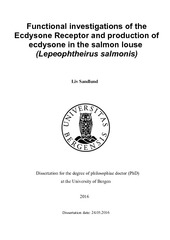| dc.contributor.author | Sandlund, Liv | |
| dc.date.accessioned | 2016-05-31T09:51:49Z | |
| dc.date.available | 2016-05-31T09:51:49Z | |
| dc.date.issued | 2016-05-24 | |
| dc.identifier.uri | https://hdl.handle.net/1956/12043 | |
| dc.description.abstract | The salmon louse Lepeophtheirus salmonis is a marine ectoparasitic copepod naturally infecting salmonid fishes in the Northern hemisphere. At present, salmon louse infections are the most severe disease problem in the salmon farming industry causing significant economical losses. Salmon louse infections on farmed fish have largely been treated with chemotherapeutants which in recent years have lead to the development of resistance towards the majority of available treatment methods. Cases of multi-resistance are reported as increasing, underlining the severity of the situation. Although non-therapeutic methods such as the use of cleaner fish have been implemented into the management of lice infestations, it is clear that new alternative methods are essential to gain control of the parasite in the future. The ecdysone hormone system and the ecdysone receptor/retinoid X receptor (EcR/RXR) complex are key regulators of molting, development and growth in arthropods. A wide range of studies has demonstrated the importance of this endocrine system in insects and to some extent in malacostraca, but knowledge about ecdysone signalling in copepods is limited. Therefore, we aimed to increase our knowledge about this hormone system in the salmon louse. In this study, the ecdysone receptor (EcR) and the key ecdysteroidogenic genes neverland (nvd), disembodied (dib) and shade (shd) were identified and functionally assessed using RNA interference studies. LsEcR transcripts were expressed in all life stages and in most tissues in both the copepodid (i.e. brain, muscle and immature intestine) and the adult female (i.e. ovaries, sub cuticula, intestine, oocytes and glandular tissue). The wide tissue distribution is expected due to the numerous physiological and biological processes that are regulated by EcR signalling. Interestingly, knock-down of LsEcR in nauplia I larvae did not cause immediate molting arrest, but developed into viable copepodids, indicating another partner of RXR. However, further incubation of the LsEcR knock-down copepodids on salmon resulted in severe tissue damage and increased mortality. During metamorphosis, an extensive range of tissues is remodelled concurrently with the molting process in order to adapt to the new life stage. The results obtained from the studies indicate that LsEcR is a key regulator of developmental processes associated with tissue remodelling and molting in L. salmonis. Ecdysteroids regulate reproductive processes in arthropods such as vitellogenesis and oocyte maturation. In the salmon louse, vitellogenin and yolk production takes place in the subcuticula before being incorporated into the oocyte. These processes showed to be indirectly affected by knock-down of LsRXR which resulted in abnormal egg chambers and no egg-production. This is supported by knock-down studies of LsEcR in pre-adult females resulted in hypotrophy of tissues associated with yolk and vitellogenin synthesis, degeneration of the oocytes and termination of egg production. This demonstrates that LsEcR plays a key role in the reproduction of the salmon louse. We have not proven that ecdysteroid signalling has a direct effect on the oocytes. However, LC/MS/MS analysis of the ecdysteroid content during oocyte maturation in adult females showed higher levels of ecdysteroids in the abdomen/genital segment (Ab/G) compared to the cephalothorax (CT), suggesting that ecdysteroids may directly affect oocyte maturation and embryogenesis. The biosynthesis of the ecdysteroids is performed by members of the cytochrome P450 family through several enzymatic reactions. The last step in the pathway is the conversion of ecdysone to the active metabolite by Shd. Knock-down of the biosynthetic genes in other species is associated with embryonic defects and mortality. Interestingly, functional assessment of LsNvd, LsDib and LsShd in L. salmonis nauplia I larvae resulted in molting arrest only in the LsShd knock-down animals, while the LsNvd, LsDib developed normally into copepodids. Based on the knock-down results and the biology of the salmon louse, we hypothesize that ecdysone are incorporated into the oocytes during maturation and is further converted by LsShd into the active metabolite during development of the lecitotrophic stages. To our knowledge, no-loss of function phenotype has been observed in nvd and dib knock-down animals during early development in other arthropods, indicating a possible novel regulation pathway in L. salmonis. | en_US |
| dc.language.iso | eng | eng |
| dc.publisher | The University of Bergen | en_US |
| dc.relation.haspart | Paper I: Liv Sandlund, Frank Nilsen, Rune Male, Sindre Grotmol, Heidi Kongshaug and Sussie Dalvin (2015). Molecular characterisation of the salmon louse, Lepeophtheirus salmonis salmonis (Krøyer, 1837), ecdysone receptor with emphasis on functional studies of female reproduction. International Journal for Parasitology, 45:175-185. The article is available in BORA at: <a href="http://hdl.handle.net/1956/10231" target="blank">http://hdl.handle.net/1956/10231</a> | en_US |
| dc.relation.haspart | Paper II: Liv Sandlund, Frank Nilsen, Rune Male and Sussie Dalvin (2016). The Ecdysone Receptor (EcR) is a Major Regulator of Tissue Development and Growth in the Marine Salmonid Ectoparasite, Lepeophtheirus salmonis (Copepoda, Caligidae). Molecular and Biochemical Parasitology. Accepted for publication after minor reviews. This article is not available in BORA. | en_US |
| dc.relation.haspart | Paper III: Liv Sandlund, Rune Male, Tor Einar Horsberg, Frank Nilsen, Heidi Kongshaug and Sussie Dalvin (2016). Identification and functional assessment of the ecdysone biosynthetic genes neverland, disembodied and shade in the salmon louse Lepeophtheirus salmonis (Copepoda, Caligidae). Submitted manuscript. This article is not available in BORA. | en_US |
| dc.subject | Laksefisker | NOB |
| dc.subject | Oppdrett | NOB |
| dc.subject | Fiskesykdommer | NOB |
| dc.subject | Hoppekreps | NOB |
| dc.subject | Hamskifte | nob |
| dc.title | Functional investigations of the Ecdysone Receptor and production of ecdysone in the salmon louse (Lepeophtheirus salmonis) | en_US |
| dc.type | Doctoral thesis | |
| dc.rights.holder | Copyright the author. All rights reserved. | en_US |
| dc.subject.realfagstermer | https://data.ub.uio.no/realfagstermer/c005036 | |
